Global Market Comments
August 6, 2021
Fiat Lux
Featured Trade:
(MAD HEDGE 2021 H1 TRADE ANALYSIS)
($INDU), (TLT), (GLD), (XME), (DAL), (FCX), (TSLA)

Global Market Comments
August 6, 2021
Fiat Lux
Featured Trade:
(MAD HEDGE 2021 H1 TRADE ANALYSIS)
($INDU), (TLT), (GLD), (XME), (DAL), (FCX), (TSLA)

I finally managed to carve out a few hours to analyze my 2021 H1 trades, and what a year it’s been!
From January 1 to June 30, the Mad Hedge Fund Trader sent you 124 trade alerts completing 64 round trips in four asset classes. These generated a profit of 70.59% in six months, more than we made all of last year.
It is the most prolific performance since we launched Mad Hedge Fund Trader 14 years ago.
In my January 6 Mad Hedge Annual Asset Class Review (click here for the link--you must be logged in to the site), I predicted that the Dow Average ($INDU) would rise 30% for the end of the year. This proved immensely valuable.
That view enabled me to go maximum aggressive, full speed ahead, damn the torpedoes. It’s not that I was so certain that the stock market would go ballistic to the upside. But with the Federal Reserve pumping trillions of dollars of quantitative easing into the economy, record deficit spending, and the pandemic coming under control, I was certain that markets would not go down.
So, I looked into my bag of tricks and pulled out a strategy ideal for this scenario, the in-the-money vertical bull call debit spread (click here for the video on how to execute one of these). Such an approach allowed me to make a maximum profit even if the underlying security went up, sideways, or down small. It worked like a charm.
Here are by trades assorted by asset class:
Equities – 44.14%
Bonds – 24.12%
Commodities – 1.52%
Precious Metals – 0.81%
2021 was definitely the year of equities. In fact, the risk/reward for equities was so compelling that it was almost a waste of time to look at anything else. Equity trades accounted for 62.53% of my total profits.
I split my equity selections with my well-known “barbell strategy” with equal allocations split between big technology and domestic recovery stocks. That way, I always had positions that were going up.
Short positions in the bond market (I had only one long trade) accounted for another 34.17% of my performance. This was basically a first-quarter trade where I caught the collapsing bond market by both lapels and shook it for all it was worth, catching a dive from $162 to $132 in the United States Treasury Bond Fund (TLT). I mostly quit bond trading in March, not wanting to visit the trough too many times in an extremely oversold condition. That was a great call.
Commodities delivered another 2.15% of return with a single trade in the SPDR S&P Metals & Mining ETF (XME). I thought exploding economic growth would cause commodity prices to soar, and they did. But there were better plays to be had buying key stocks in the sector directly, such as Freeport McMoRan (FCX).
As an afterthought, I made another 1.15% in precious metals with two trades long gold. I thought gold would go up this year but so far, no luck. The gold (GLD) faded away when US Treasury bonds became the asset class of choice from March onward.
Of 64 round trips, I lost money on only four, giving me a success rate of 93.75%, far and away the best in the industry. One was a short in Tesla (TSLA) in the $800s. It later fell to $550. The next was a long in Tesla. I got stopped out when it fell below $600. That’s OK because I made a 10X return trading Tesla in 2020.
Welcome to show business.
The next hickey came from a long in Microsoft (MSFT) which I got stopped out of. It went straight up afterwards. Then I took a small hit in Delta Airlines (DAL) for the same reason. The higher the market goes, the faster I stop out as part of my risk control discipline.
All in all, it’s been one hell of a year. I cut back my trading dramatically in June and July partly because the market was so incredibly high, but also to give my loyal staff a rest. Imagine working double overtime for a year and a half! How about sending out 13 trade alerts out in one day!
We are now all refreshed and well-rested ready to take on all comers in H2. The harder I work, the luckier I get. It really is true.
As I tell my beginning traders, work in, money out.
To download the entire 2021 H1 trade history, please click here.
Good Luck and Good Trading
John Thomas
CEO & Publisher
The Diary of a Mad Hedge Fund Trader

Capturing Peak Profits
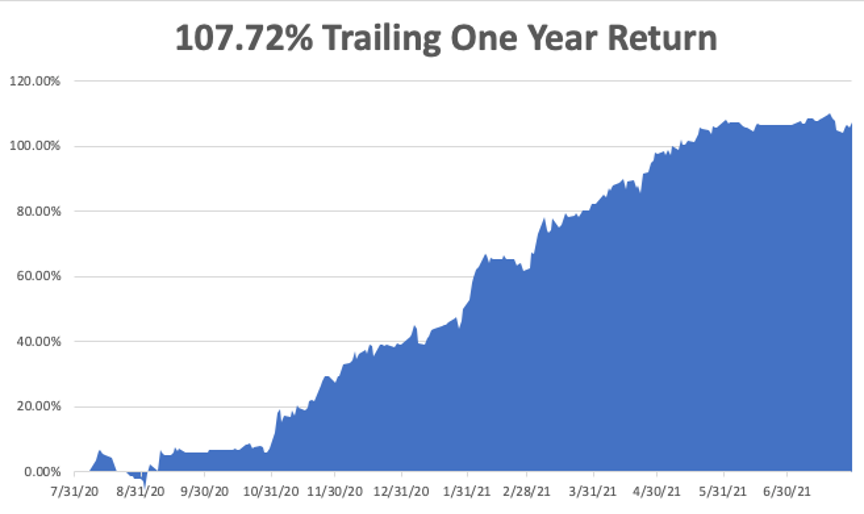
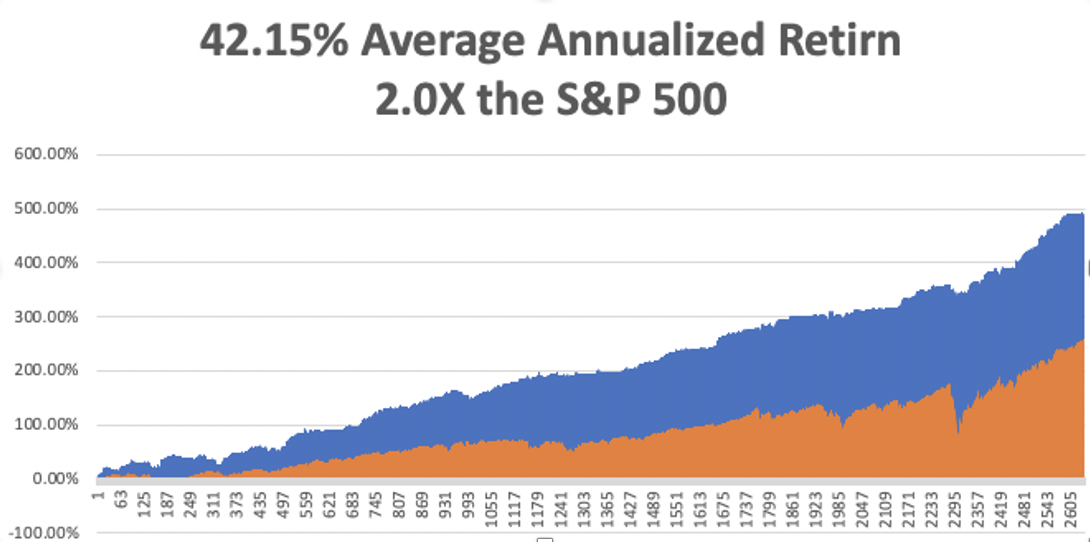

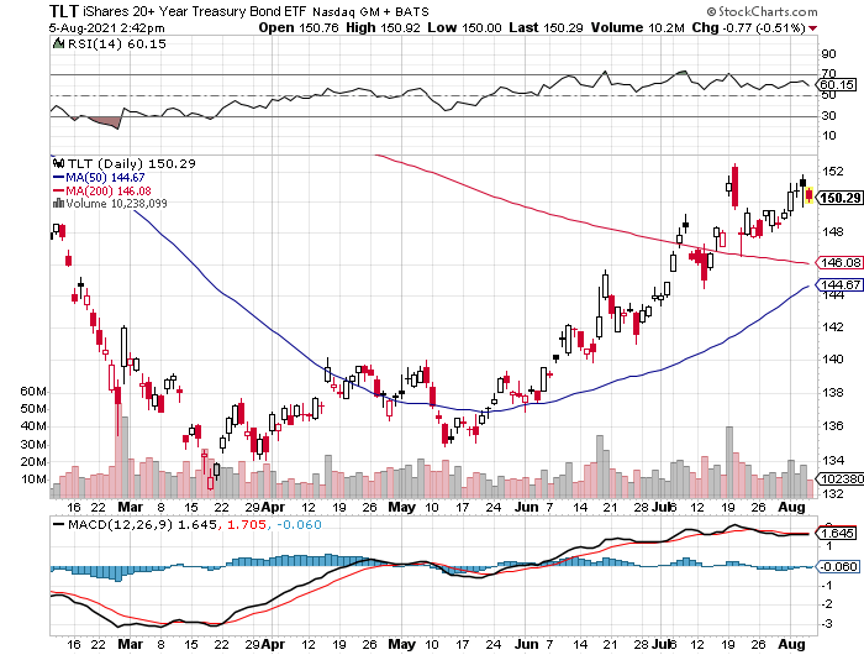
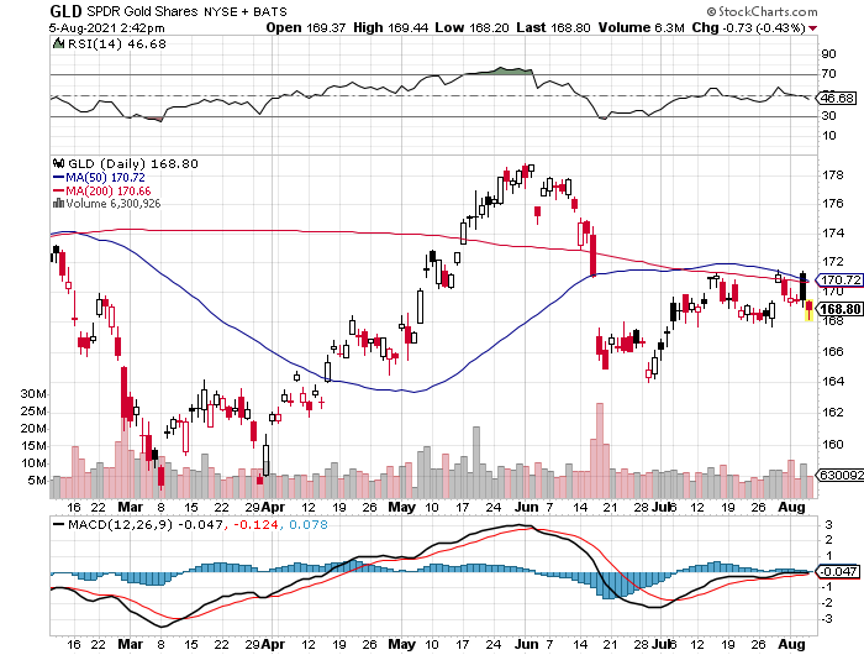

Global Market Comments
June 18, 2021
Fiat Lux
Featured Trade:
(JUNE 16 BIWEEKLY STRATEGY WEBINAR Q&A),
(MS), (XOM), (FXI), (MSFT), (AMZN), (FB), (GOOGL), FCX), (CAT),
(GLD), (DIS), (GME), (AMC), (UBER), (LYFT), (TLT), (VIX)

Below please find subscribers’ Q&A for the June 16 Mad Hedge Fund Trader Global Strategy Webinar broadcast from Lake Tahoe, NV.
Q: Does Copper (FCX) look like a buy now or wait for it to drop?
A: I would buy ⅓ now, ⅓ lower down, ⅓ lower down still. Worst case we get down to $30 in Freeport McMoRan (FCX) from $37 today. A new internal combustion engine requires 40 lbs. of copper for wiring, but new EVs require 200 lbs. per car, and the number of EV cars is about to go from 700,000 last year to 25 million in 10 years. So, you can do the math here. It's basically 24.3 million times 200 lbs., or 1.215 billion tons, and that's the annual increase in demand for copper over the next 10 years. There aren’t enough mines in the world to accommodate that, so the price has to go up. However, (FCX) has gone up 12 times from its 2020 low and was overdue for a major rest. So short term it's a sell, long term it's a double. That's why I put the LEAPS out on it.
Q: Lumber prices are dropping fast, should I bet the ranch that it’ll drop big?
A: No, I think the big drop has happened; we’re down 40% from the highs, the next move is probably up. And that is a commodity that will remain more or less permanently in short supply due to the structural impediments put into the lumber market by the Trump administration. They greatly increased import duties from Canada and all those Canadian mills shut down as a result. It’s going to take a long time to bring those back up to speed and get us the wood we need to build houses. Another interesting thing you’re seeing in the bay area for housing is people switching over to aluminum and steel for framing because it’s cheaper, and of course in an earthquake-prone fire zone, you’d much rather have steel or aluminum for framing than wood.
Q: I didn’t catch the (FCX) LEAP, can you reiterate?
A: With prices at today's level, you can buy the 35 calls in (FCX), sell short the 40 calls, and get nearly a 177% return by January 2022. That's an absolute screamer of a LEAPS.
Q: How do you see the working from home environment in the near future after Morgan Stanley (MS) asked everyone to return?
A: Well that’s just Morgan Stanley and that’s in New York. They have their own unique reasons to be in New York, mostly so they can meet and shake down all their customers in Manhattan—no offense to Morgan Stanley, but I used to work there. For the rest of the country, those in remote places already, a lot of companies prefer that people keep working from home because they are happier, more productive, and it’s cheaper. Who can beat that? That’s why a lot of these productivity gains from the pandemic are permanent.
Q: Is there a recording of the previous webinar?
A: Yes, all of the webinars for the last 13 years are on the website and can be accessed through your account.
Q: What makes Microsoft (MSFT) a perfect-looking chart?
A: Constant higher lows and higher highs. They also have a fabulous business which is trading relatively cheaply to the rest of tech and the rest of the main market. Of course, they were a huge pandemic winner with all the people rushing out to buy PCs and using Microsoft operating software. I expect those gains to improve. The new game now is the “wide moat” strategy, which is buying companies that have near monopolies and can’t be assailed by other companies trying to break into their businesses. The wide moat businesses are of course Microsoft (MSFT), Amazon (AMZN), Facebook (FB) and Alphabet (GOOGL). That's the new investment philosophy; that's why money has been pouring back into the FANGs for a month now.
Q: Do you have any concerns about Facebook’s (FB) advertising ability, given the recent reduction of tracking capabilities of IOS 4.5 users?
A: Well first of all, IOS 4.5 users, the Apple operating system, are only 15% of the market in desktops and 24% of mobile phones. Second, every time one of these roadblocks appears, Facebook finds a way around it, and they end up taking in even more advertising revenue. That’s been the 15-year trend and I'm sticking to it.
Q: Is Caterpillar (CAT) a LEAP candidate right now?
A: Not yet, but we’re getting there. Like many of these domestic recovery plays, it is up 200% from the March lows where we recommended it. The best time to do LEAPS is after these big capitulation selloffs, and all we’ve really seen in most sectors this year is a slow grind down because there's just too much money sitting under the market trying to get into these stocks. Let’s see if (CAT) drops to the 50-day moving average at $185 and then ask me again.
Q: If you have the (FCX) LEAPS, should you keep them?
A: I would keep them since I'm looking for the stock to double from here over the next year. If you have the existing $45-$50 LEAPS, I would expect that to expire at its max profit point in January. But you may need to take a little pain in the interim until it turns.
Q: Should I bet the ranch on meme stocks like (AMC) and GameStop GME)?
A: Absolutely not, I’m amazed you haven't lost everything already.
Q: Do you think Exxon-Mobile (XOM) could rise 30% from here?
A: Yes, if we get a 30% rise in oil. We are in a medium-term countertrend rally in oil which will eventually burn out and take us to new lows. Trade against the trend at your own peril.
Q: Disneyland (DIS) in Paris is set to open. Is Disneyland a buy here?
A: Yes, we’re getting simultaneous openings of Disneyland’s worldwide. I’ve been to all of them. So yes, that will be a huge shot in the arm. Their streaming business is also going from strength to strength.
Q: How long will the China (FXI) slowdown last?
A: Not long, the slowdown now is a reaction to the superheated growth they had last year once their epidemic ended. We should get normalized growth in China at around 6% a year, and I expect China to rally once that happens.
Q: Have you changed your outlook on inflation, real or imagined?
A: I don’t think we’re going to have inflation; I buy the Fed's argument that any hot inflation numbers are temporary because we’re coming off of a one-on-one comparisons from when the economy was closed and the prices of many things went to zero. If you look at that inflation number, it had trouble written all over it. Some one third of the increase was from rental cars. One of the hottest components was used cars. You’re not going to get 100% year on year increases next year in rental or used cars.
Q: When you issue a trade alert, it’s always in the form of a call spread like the Microsoft (MSFT) $340-$370 vertical bull call spread. What are the pros and cons of doing this trade on the put side, like shorting a vertical bear put spread?
A: It’s six of one, half a dozen of the other. There are algorithms that arbitrage between the two positions that make sure that they’re never out of line by more than a few cents. I put out call spreads because they’re easier for beginners to understand. People get buying something and watching it go up. They don’t get borrowing something, selling it short, and buying it back cheaper.
Q: Will gold (GLD) prices go up?
A: Yes, when inflation goes up for real.
Q: What is the future of the gig economy? How will that affect Uber (UBER) and Lyft (LYFT)?
A: I like both, because they just got a big exemption from California on part time workers, and that is very positive for their business models.
Q: Do you think the government doesn’t want to cancel student debt because it will unleash inflation?
A: It’s the exact opposite. The government wants to forgive student debt because it will unleash inflation. If you add 10 million new consumers to the economy, that is very positive. As long as former students have tons of debt, horrible credit ratings, and are unable to buy homes or get credit cards, they are shut out of the economy. They can’t participate in the main economy by buying homes, shopping, or getting credit. The fact that the US has so many college grads is why businesses succeed here and fail in every other country. That should be encouraged.
Q: Where is the United States US Treasury Bond Fund (TLT) headed?
A: Short term up, long term down.
Q: Options premiums are not melting away much today; I hope they start decaying after the Fed announcement.
A: In these elevated volatility periods—believe it or not, the (VIX) is still elevated compared to its historic levels—they hang on all the way to the very last day, before expiration, before they really melt the time value on options. It really does pay to run these into expiration now. When the VIX was down at like $9-$10, that was not the case.
Q: I bought a short term expiration going long the (TLT) to hedge my position; was this smart?
A: Yes, but only if you are a professional short-term trader. If you are in front of your screen all day and are able to catch these short term moves in (TLT), that is smart. My experience is that most individual investors don’t have the experience to do that, don’t want to sit in front of a screen all day, and would rather be playing golf. Such hedging strategies end up costing them money. Also, remember that half of the moves these days are at the opening; they’re overnight gap openings and you can’t catch that intraday trading—it’s not possible. So over time, the people who take the most risk make the most money. And that means the people who don’t hedge make the most money. But you have to be able to take the pain to do that. So that’s my philosophy talk on risk taking.
To watch a replay of this webinar with all the charts, bells, whistles, and classic rock music, just log in to www.madhedgefundtrader.com , go to MY ACCOUNT, click on GLOBAL TRADING DISPATCH, then WEBINARS, and all the webinars from the last ten years are there in all their glory.
Good Luck and Stay Healthy
John Thomas
CEO & Publisher
The Diary of a Mad Hedge Fund Trade

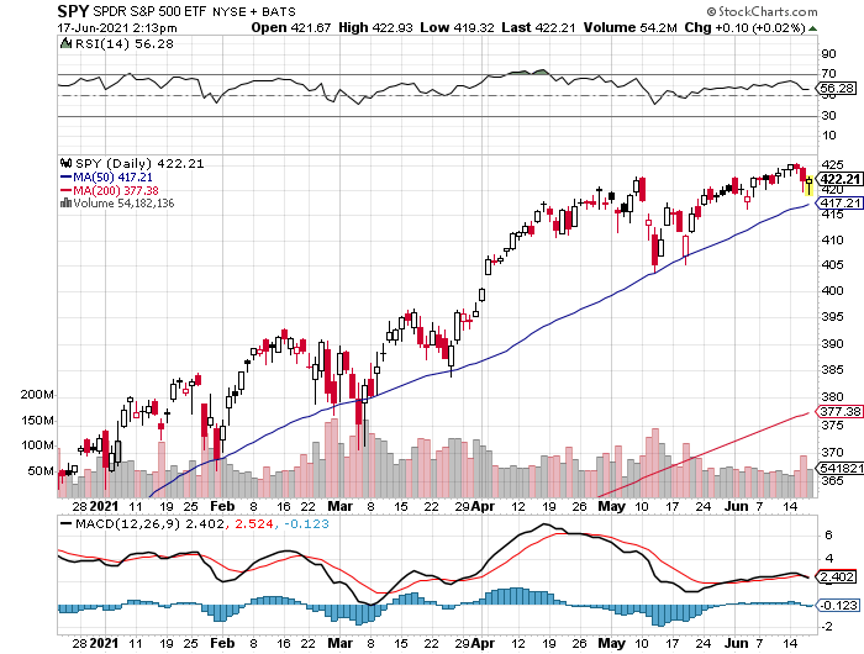
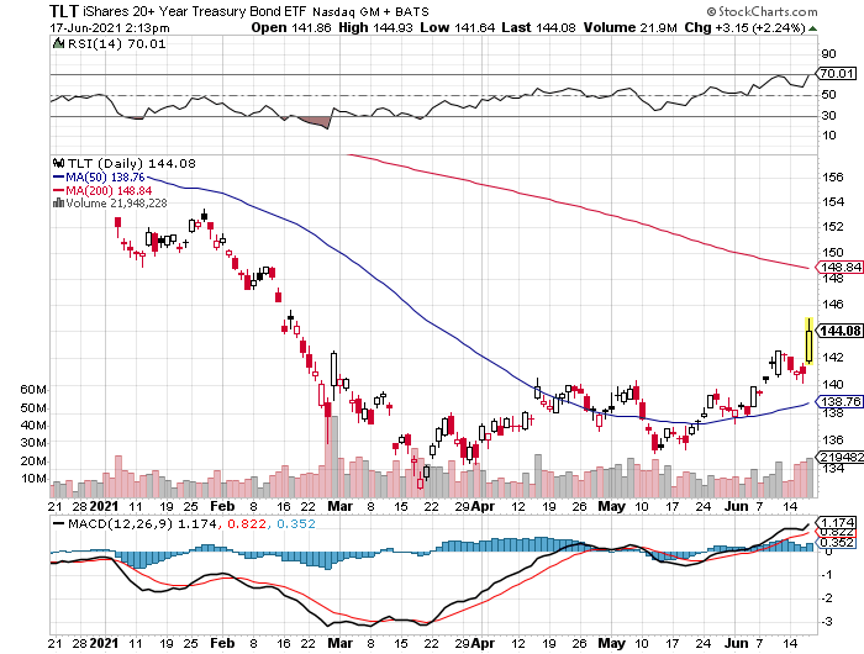
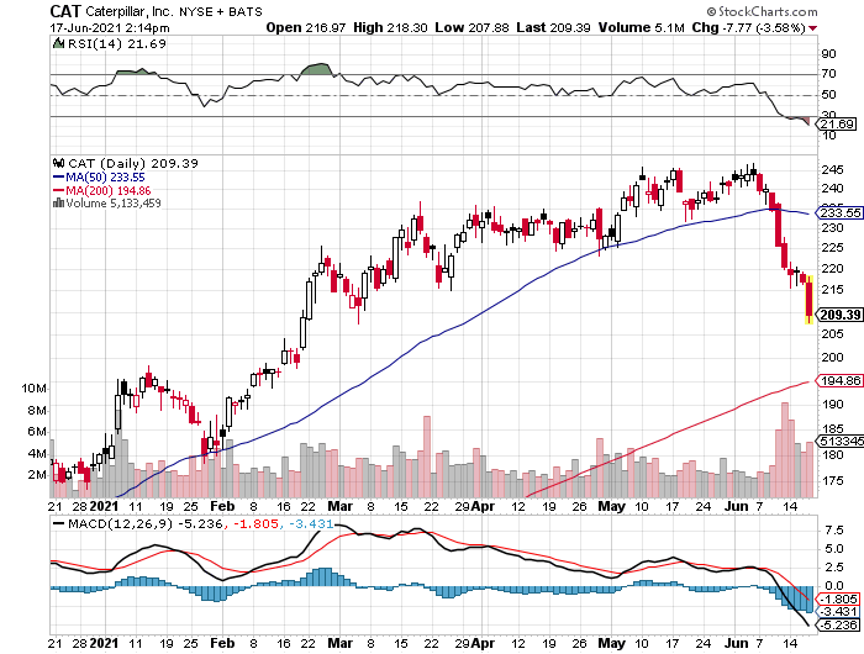
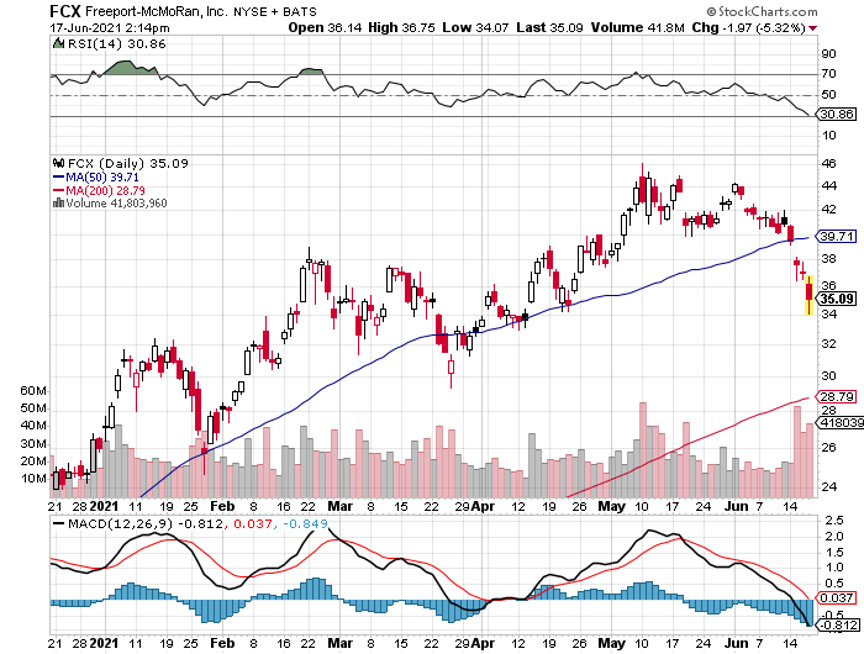
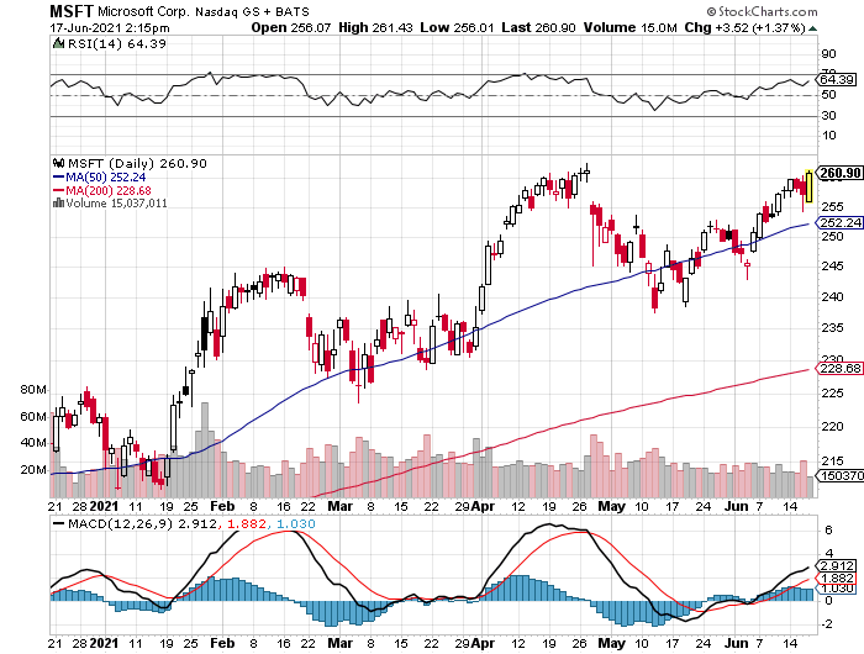
Global Market Comments
April 27, 2021
Fiat Lux
Featured Trade:
(THE SECRET FED PLAN TO BUY GOLD),
(GLD), (GDX), (PALL), (PPLT),
(TESTIMONIAL)

With the latest effort to expand quantitative easing through the Fed purchase of individual corporate bonds, we must consider what else our central bank has up its sleeve.
With American interest rates already near zero, the markets will take the rates for all interest-bearing securities well into negative numbers. This has already happened in Japan and Germany.
At that point, our central bank’s primary tool for stimulating US businesses will become utterly useless, ineffective, and impotent.
What else is in the tool bag?
How about large-scale purchases of Gold (GLD)?
You are probably as shocked as I am with this possibility. But there is a rock-solid logic to the plan. As solid as the vault at Fort Knox.
This theory gained credence when my old friend, Judy Shelton, was appointed to the federal reserve, a noted gold bug.
The idea is to create asset price inflation that will spread to the rest of the economy. It already did this with great success from 2009-2014 with quantitative easing, whereby almost every class of debt securities were hoovered up by the government.
“QE on steroids”, to be implemented only after overnight rates go negative, would involve large-scale purchases of not only gold, but stocks, government bonds, and exchange-traded funds as well. Corporate bond purchases are simply a step in that direction.
If you think I’ve been smoking California’s largest cash export (it’s not the raisins) you would be in error. I should point out that the Japanese government is already pursuing QE to this extent, at least in terms of equity-type investments and ETFs, and already owns a substantial part of the Japanese stock market.
And, as the history buff that I am, I can tell you that it has been done in the US as well, with tremendous results.
If you thought that President Obama had it rough when he came into office in 2009 with the Great Recession on, it was nothing compared to what Franklin Delano Roosevelt inherited.
The country was in its fourth year of the Great Depression. US GDP had cratered by 43%, consumer prices crashed by 24%, the unemployment rate was 25%, and stock prices vaporized by 90%. Mass starvation loomed.
Drastic measures were called for.
FDR issued Executive Order 6102 banning private ownership of gold, ordering them to sell their holdings to the US Treasury at a lowly $20.67 an ounce.
He then urged Congress to pass the Gold Reserve Act of 1934, which instantly revalued the government’s holdings at $35.00, an increase of 69.32%. These and other measures caused the value of America’s gold holdings to leap from $4 to $12 billion. That’s a lot of money in 1934 dollars, about $208 billion in today’s money.
Since the US was still on the gold standard back then, this triggered an instant dollar devaluation of more than 50%. The high gold price sucked in massive amounts of the yellow metal from abroad creating, you guessed it, inflation.
The government then borrowed massively against this artificially created wealth to fund the landscape-altering infrastructure projects of the New Deal.
It worked.
During the following three years, the GDP skyrocketed by 48%, inflation eked out a 2% gain, the unemployment rate dropped to 18%, and stocks jumped by 80%. Happy days were here again.
Monetary conditions are remarkably similar today to those that prevailed during the last government gold buying binge.
There has been a de facto currency war underway since 2009. The Fed started when it launched QE, and Japan, Europe, and China have followed. Blue-collar unemployment and underpayment are at a decades high. The need for a national infrastructure program is overwhelming.
However, in the 21st century version of such a gold policy, it is highly unlikely that we would see another gold ownership ban.
Instead, the Fed would most likely move into the physical gold market, sitting on the bid for years, much like it recently did in the Treasury bond market for five years. Gold prices would increase by a multiple of current levels.
It would then borrow against its new gold holdings, plus the 4,176 metric tonnes worth $200 billion at today’s market prices already sitting in Fort Knox, to fund a multi trillion-dollar infrastructure spending program.
Heaven knows we need it. Millions of blue-collar jobs would be created, and inflation would come back from the dead.
Yes, this all sounds like a fantasy. But negative interest rates were considered an impossibility only years ago.
The Fed’s move on gold would be only one aspect of a multi-faceted package of desperate last-ditch measures to extend economic growth into the future which I outlined in a previous research piece (click here for “What Happens When QE Fails” by clicking here).
That’s assuming that the gold is still there. Treasury Secretary Stephen Mnuchin says he saw the gold himself during an inspection that took place on the last solar eclipse over Fort Knox in 2018. The door to the vault at Fort Knox had not been opened since September 23, 1974.
But then Steve Mnuchin says a lot of things. Persistent urban legends and internet rumors claim that the vault is actually empty or filled with fake steel bars painted gold.
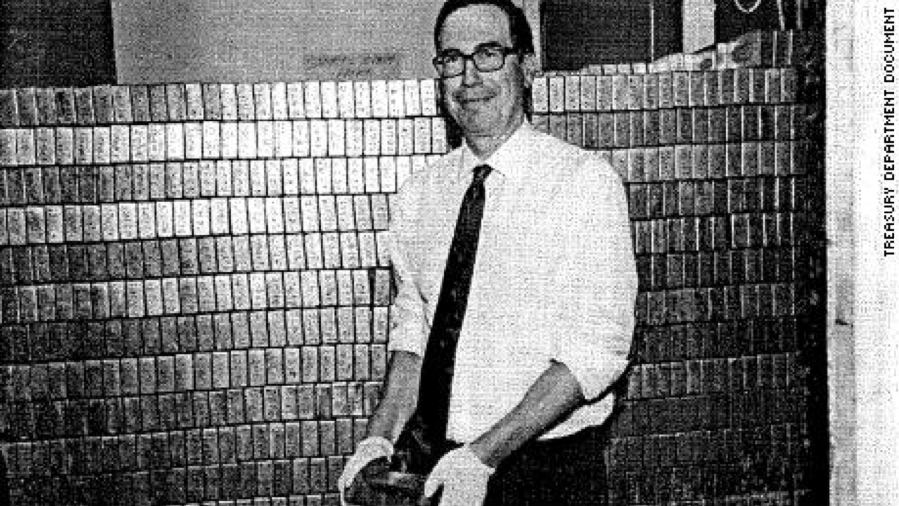
But is it Really Gold?
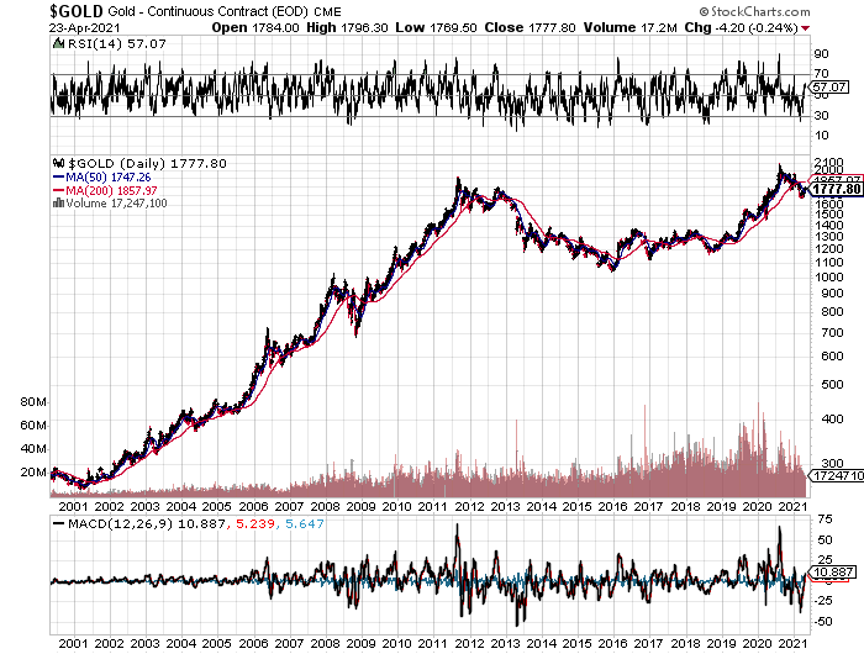
You Can See the Upside Breakout Coming Clear as Day

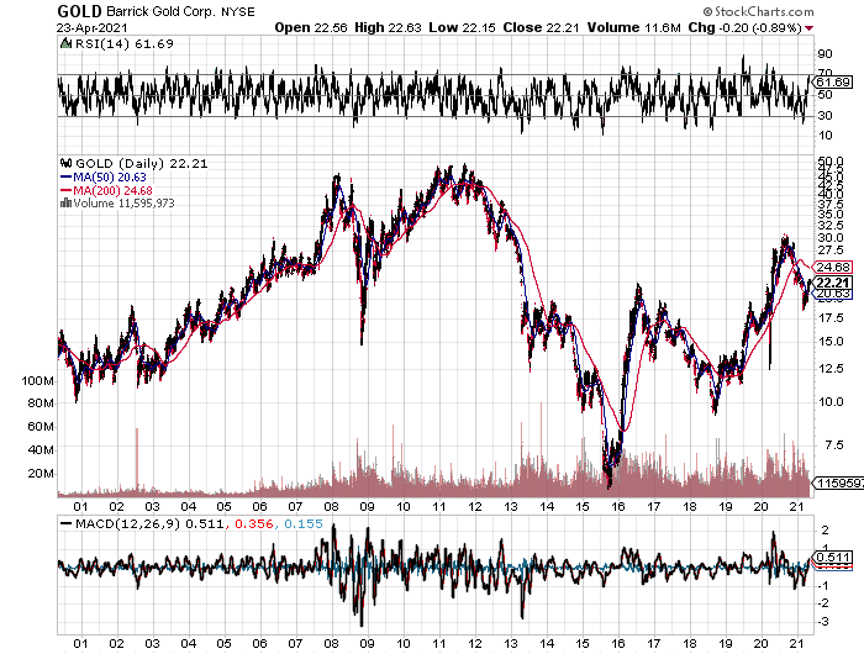
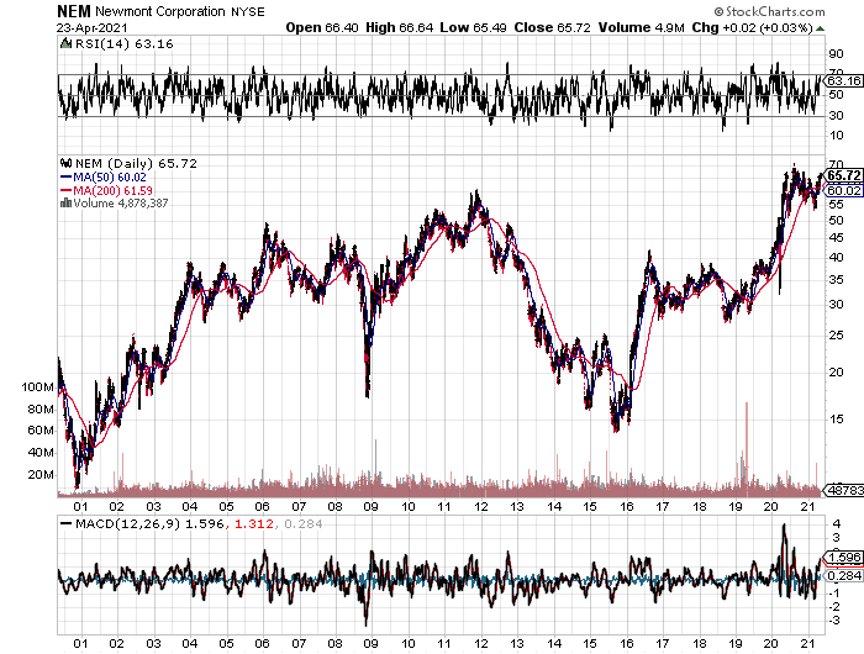

Global Market Comments
April 1, 2021
Fiat Lux
Featured Trade:
(MARCH 31 BIWEEKLY STRATEGY WEBINAR Q&A),
(FB), (ZM), ($INDU), (X), (NUE), (WPM), (GLD), (SLV), (KMI), (TLT), (TBT), (BA), (SQ), (PYPL), (JNP), (CP), (UNP), (TSLA), (GS), (GM), (F)

Below please find subscribers’ Q&A for the March 31 Mad Hedge Fund Trader Global Strategy Webinar broadcast from frozen Incline Village, NV.
Q: Would you buy Facebook (FB) or Zoom (ZM) right here?
A: Well, Zoom was kind of a one-hit wonder; it went up 12 times on the pandemic as we moved to a Zoom economy, and while Zoom will permanently remain a part of our life, you’re not going to get that kind of growth in stock prices in the future. Facebook on the other hand is going to new highs, they just announced they’re laying a new fiber optic cable to Asia to handle a 70% increase in traffic there. So, for the longer term and buying here, I think you get a new high on Facebook soon; there's maybe another 20-30% move in Facebook this year.
Q: I can’t really chase these trades here, right?
A: Correct; if you wait any more than a day or 2 on executing a trade alert, you’re missing out on all of the market timing value we bring to the game. So that's why I include an entry price and the “don’t pay more than” price. And we never like to chase, except last year, when we did it almost all the time. But last year was a chase market, this year not so much.
Q: How are LEAP purchase notifications transmitted?
A: Those go out in the daily newsletter Global Trading Dispatch when I see a rare entry point for a LEAP, then we’ll send out a piece and notify everybody. But it’s very unusual to get those. Of course, a year ago we were sending out lists of LEAPS ten at a time when the Dow Average ($INDU) is at 18,000. But that is not now, you only wait for those once or twice a year. On huge selloffs to get into two-year-long options trades, and that is definitely not now. The only other place I've been looking out for LEAPS right now are really bombed out technology stocks begging for a rotation. Concierge members get more input on LEAPS and that is a $10,000 a year upgrade.
Q: What are your thoughts on silver (SLV) and long-term gold (GLD)?
A: I see silver going to $50 and eventually $100 in this economic cycle, but it's out of favor right now because of rising interest rates. So, once we hit 2.00% in the ten years, it’s not only off to the races for tech but also gold and silver. Watch that carefully because your entry point may be on the horizon. That makes Wheaton Precious Metals (WPM) a very attractive “BUY” right now.
Q: Are you going to trade the (TLT)?
A: Absolutely yes, but I’m kind of getting picky now that I’m up 42% on the year; and I only like to sell 5-point rallies, which we got for about 15 minutes last week. And I also only like to buy 5- or 10-point dips. Keep your trading discipline and you’ll make a ton of money in this market. Last year we made about 30% trading bonds on about 30 round trips.
Q: How much further upside is there for US Steel (X) and Nucor Corp. (NUE)?
A: More. There's no way you do infrastructure without using millions of tons of steel. And I kind of missed the bottom on US Steel because it had been a short for so long that it kind of dropped off the radar for me. I think we have gone from $4 to 27 since last year, but I think it goes higher. It turns out the US has been shutting down steel production for decades because it couldn't compete with China or Japan, and now all of a sudden, we need steel, and we don’t even make the right kind of steel to build bridges or subways anymore—that has to be imported. So, most of the steel industry here now is working for the car industry, which produces cold-rolled steel for the car body panels. Even that disappears fairly soon as that gets taken over by carbon fiber. So enough about steel, buy the dips on (X) and (NUE).
Q: What stocks should I consider for the infrastructure project?
A: Well, US Steel (X) and Nucor Corp (NUE) would be good choices; but really you can buy anything because the infrastructure package, the way it’s been designed, is to benefit the entire economy, not just the bridge and freeway part of it. Some of it is for charging stations and electric car subsidies. Other parts are for rural broadband, which is great for chip stocks. There is even money to cap abandoned oil wells to rope in Texas supporters. All of this is going to require a massive upgrade of the power grid, which will generate lots of blue-collar jobs. Really everybody benefits, which is how they get it through Congress. No Congressperson will want to vote against a new bridge or freeway for their district. That’s always the case in Washington, which is why it will take several months to get this through congress because so many thousands of deals need to be cut. I’ve been in Washington when they’ve done these things, and the amount of horse-trading that goes on is incredible.
Q: Is it a good thing that I’ve had the United States Treasury Bond Fund (TLT) LEAPS $125 puts for a long time.
A: Yes. Good for you, you read my research. Remember, the (TLT) low in this economic cycle is probably around $80, so you probably want to keep rolling forward your position….and double up on any ten-point rally.
Q: Do you think we get a pop back up?
A: We do but from a lower level. I think any rallies in the bond market are going to be extremely limited until we hit the 2.00%, and then you’re going to get an absolute rip-your-face-off rally to clean out all the short term shorts. If you're running put LEAPS on the (TLT) I would hang on, it’s going to pay off big time eventually.
Q: If we see 3.00% on the 10-year this year, do you see the stock market crashing?
A: I don’t think we’ll hit 3.00% until well into next year, but when we do, that will be time for a good 10% stock market correction. Then everyone will look around again and say, “wow nothing happened,” and that will take the market to new highs again; that's usually the way it plays out. Remember, then year yields topped all the way up at 5.00% when the Dotcom Bubble topped in April 2020.
Q: Has the airline hospitality industry already priced in the reopening of travel?
A: No, I think they priced in the hope of a reopening, but that hasn’t actually happened yet, and on these giant recovery plays there are two legs: the “hope for it” leg, which has already happened, and then the actual “happening” leg which is still ahead of us. There you can get another double in these stocks. When they actually reopen international travel to Europe and Asia, which may not happen this year, the only reopening we’re going to see in the airline business is in North America. That means there is more to go in the stock price. Also coming back from the brink of death on their financial reports will be an additional positive.
Q: Do you think a corporate tax increase will drive companies out of the US again and raise the unemployment rate?
A: Absolutely not. First of all, more than half of the S&P 500 don’t even pay taxes, so they’re not going anywhere. Second, I think they will make these offshoring moves to tax-free domiciles like Ireland illegal and bring a lot of tax revenues back to the US. And third, all Biden is doing is returning the tax rate to where it was in 2017; and while the corporate tax rate was 35%, the stock market went up 400% during the Obama administration, if you recall. So stocks aren't really that sensitive to their tax rates, at least not in the last 50 years that I’ve been watching. I'm not worried at all. And Biden was up on the polls a year ago talking about a 28% tax rate; and since then, the stock market has nearly doubled. The word has been out for a year and priced in for a year, and I don't think anybody cares.
Q: What about quantum computers?
A: I’m following this very closely, it’s the next major generation for technology. Quantum computers will allow a trillion-fold improvement in computing power at zero cost. And when there's a stock play, I will do it; but unfortunately, it’s not (IBM), because we’re not at the money-making stage on these yet. We are still at the deep research stage. The big beneficiaries now are Alphabet (GOOGL), Microsoft (MSFT), and Amazon (AMZN).
Q: Is it time to buy Chinese stocks?
A: I would say yes. I would start dipping in here, especially on the quality names like Tencent (TME), Baidu (BIDU), and Alibaba (BABA), because they’ve just been trashed. A lot of the selloff was hedge fund-driven which has now gone bust, and I think relations with China improve under Biden.
Q: Your timing on Tesla (TSLA) has been impeccable; what do you look for in times of pivots?
A: Tesla trades like no other stock, I have actually lost money on a couple of Tesla trades. You have to wait for things to go to extremes, and then wait two more days. That seems to be the magic formula. On the first big selloff go take a long nap and when you wake up, the temptation to buy it will have gone away. It always goes up higher than you expect, and down lower than you expect. But because the implied volatilities go anywhere from 70% to 100%, you can go like 200 points out of the money on a 3-week view and still make good money every month. And that’s exactly what we’re going to do for the rest of the year, as long as the trading’s down here in the $500-$600 range.
Q: Is Editas Medicine (EDIT), a DNA editing stock, still good?
A: Buy both (EDIT) and Crisper (CRSP); they both look great down here with an easy double ahead. This is a great long-term investment play with gene editing about to dominate the medical field. If you want to learn more about (EDIT) and (CRSP) and many others like them, subscribe to the Mad Hedge Fund Biotech & Healthcare Letter because we cover this stuff multiple times a week (click here).
Q: Is the XME Metals ETF a buy?
A: I would say yes, but I'd wait for a bigger dip. It’s already gone up like 10X in a year, but the outlook for the economy looks fantastic. (XME) has to double from here just to get to the old 2008 high and we have A LOT more stimulus this time around.
Q: What about hydrogen?
A: Sorry, I am just not a believer in hydrogen. You have to find someone else to be bullish on hydrogen because it’s not me. I've been following the technology for 50 years and all I can say is: go do an image Google for the name “Hindenburg” and tell me if you want to buy hydrogen. Electricity is exponentially scalable, but Hydrogen is analog and has to be moved around in trucks that can tip over and blow up at any time. Hydrogen batteries are nowhere near economic. We are now on the eve of solid-state lithium-ion batteries which improve battery densities 20X, dropping Tesla battery weights from 1,200 points to 60 pounds. So “NO” on hydrogen. Am I clear?
Q: Why do you do deep-in-the-money call and put spreads?
A: We do these because they make money whether the stock goes up down or sideways, we can do them on a monthly basis, we can do them on volatility spikes, and make double the money you normally do. The day-to-day volatility on these positions is very low, so people following a newsletter don’t get these huge selloffs and sell at bottoms, which is the number one source of retail investor losses. After 13 years of trade alerts, I have delivered a 40.30% average annualized return with a quarter of the market volatility. Most people will take that.
Q: Is ProShares Ultra Short 20 Year Plus Treasury ETF(TBT) still a play for the intermediate term?
A: I would say yes. If ten-year US Treasury bonds Yields soar from 1.75% to 5.00% the (TBT) should rise from $21 to $100 because it is a 2X short on bonds. That sounds like a win for me, as long as you can take short term pain.
Q: What is the timing to buy TLT LEAPS?
A: The answer was in January when we were in the $155-162 range for the (TLT). Down here I would be reluctant to do LEAPS on the TLT because we’ve already had a $25 point drop this year, and a drop of $48 from $180 high in a year. So LEAP territory was a year ago but now I wouldn’t be going for giant leveraged trades. That train has left the station. That ship has sailed. And I can’t think of a third Metaphone for being too late.
Q: Would you buy Kinder Morgan (KMI) here?
A: That’s an oil exploration infrastructure company. No, all the oil plays were a year ago, and even six months ago you could have bought them. But remember, in oil you’re assuming you can get in and out before it crashes again, it’s just a matter of time before it does. I can do that but most of you probably can’t, unless you sit in front of your screens all day. You’re betting against the long-term trend. It works if you’re a hedge fund trader, not so much if you are a long-term investor. Never bet against the long-term trend and you always have a tailwind behind you. All surprises work to your benefit.
Q: If you get a head and shoulders top on bitcoin, how far does it fall?
A: How about zero? 80% is the traditional selloff amount for Bitcoin. So, the thing is: if bitcoin falls you have to worry about all other investments that have attracted speculative interest, which is essentially everything these days. You also have to worry about Square (SQ), PayPal (PYPL), and Tesla (TSLA), which have started processing Bitcoin transactions. Bitcoin risk is spread all over the economy right now. Those who rode the bandwagon up will ride it back down.
Q: Is Boeing (BA) a long-term buy?
A: Yes, especially because the 737 Max is back up in the air and China is back in the market as a huge buyer of U.S. products after a four-year vacation. Airlines are on the verge of seeing a huge plane shortage.
Q: What about Ags?
A: We quit covering years ago because they’re in permanent long-term downtrends and very hard to play. US farmers are just too good at their jobs. Efficiencies have double or tripled in 60 years. Ag prices are in a secular 150-year bear market thanks to technology.
Q: Is this recorded to watch later?
A: Yes, it goes on our website in about two hours. For directions on where to find it, log in to your www.madhedgefundrader.com account, go to “My Account,” and it will be listed under there, as are all the recorded webinars of the last 12 years.
Q: Would you buy Canadian Pacific (CP) here, the railroad?
A: No, that news is in the price. Go buy the other ones—Union Pacific (UNP) especially.
Q: What are your thoughts on Bitcoin?
A: We don’t cover Bitcoin because I think the whole thing is a Ponzi scheme, but who am I to say. There is almost ten times more research and newsletters out there on Bitcoin as there is on stock trading right now. They seem to be growing like mushrooms after a spring storm. There are always a lot of exports out there at market tops, as we saw with gold in 2010 and tech stock in 2000.
Q: What do you think about Juniper Networks (JNP)?
A: It’s a Screaming “BUY” right here with a double ahead of it in two years. I’m just waiting for the tech rotation to get going. This is a long-term accumulate on dips and selloffs.
Q: Did the Archagos Investments hedge fund blow threaten systemic risk?
A: No, it seems to be limited just to this one hedge fund and just to the people who lent to it. You can bet banks are paring back lending to the hedge fund industry like crazy right now to protect their earnings. I don’t think it gets to the systemic point, but this is the Long Term Capital Management for our generation. I was involved in the unwind of the last LTCM capital, which was 23 years ago. I was one of the handful of people who understood what these people were even doing. So, they had to bring me in on the unwind and huge fortunes were made on that blowup by a lot of different parties, one of which was Goldman Sachs (GS). I can tell you now that the statute of limitations has run out and now that it's unlikely I'll ever get a job there, but Goldman made a killing on long-term capital, for sure.
Q: Will Tesla benefit from the Biden infrastructure plan?
A: I would say Tesla is at the top of the list of companies the Biden administration wants to encourage. That means more charging stations and more roads, which you need to drive cars on, and bridges, and more tax subsidies for purchases of new electric cars. It’s good not just Tesla but everybody’s, now that GM (GM) and Ford (F) are finally starting to gear up big numbers of EVs of their own. By the way, I don't see any of the new startups ever posing a threat to Tesla. The only possible threats would be General Motors, Ford, and Volkswagen, which are all ten years behind.
Q: Would you put 10% of your retirement fund into cryptocurrencies?
A: Better to flush it down the toilet because there’s no commission on doing that.
Q: Is growing debt a threat to the economy? How much more can the government borrow?
A: It appears a lot more, because Biden has already indicated he’s going to spend ten trillion dollars this year, and the bond market is at a 1.70%—it’s incredibly low. I think as long as the Fed keeps overnight rates at near-zero and inflation doesn't go over 3%, that the amount the government can borrow is essentially unlimited, so why stop at $10 or $20 trillion? They will keep borrowing and keep stimulating until they see actual inflation, and I don’t think we will see that for years because inflation is being wiped out by technology improvements, as it has done for the last 40 years. The market is certainly saying we can borrow a lot more with no serious impact on the economy. But how much more nobody knows because we are in uncharted territory, or terra incognita.
To watch a replay of this webinar just log in to www.madhedgefundtrader.com , go to MY ACCOUNT, click on GLOBAL TRADING DISPATCH, then WEBINARS, and all the webinars from the last ten years are there in all their glory.
Good Luck and Stay Healthy.
John Thomas
CEO & Publisher
The Diary of a Mad Hedge Fund Trader

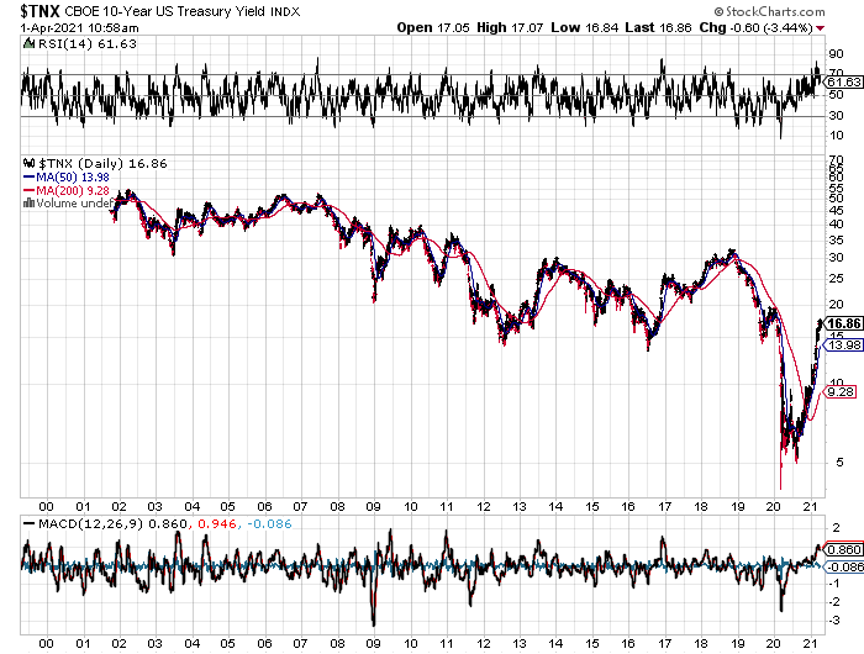
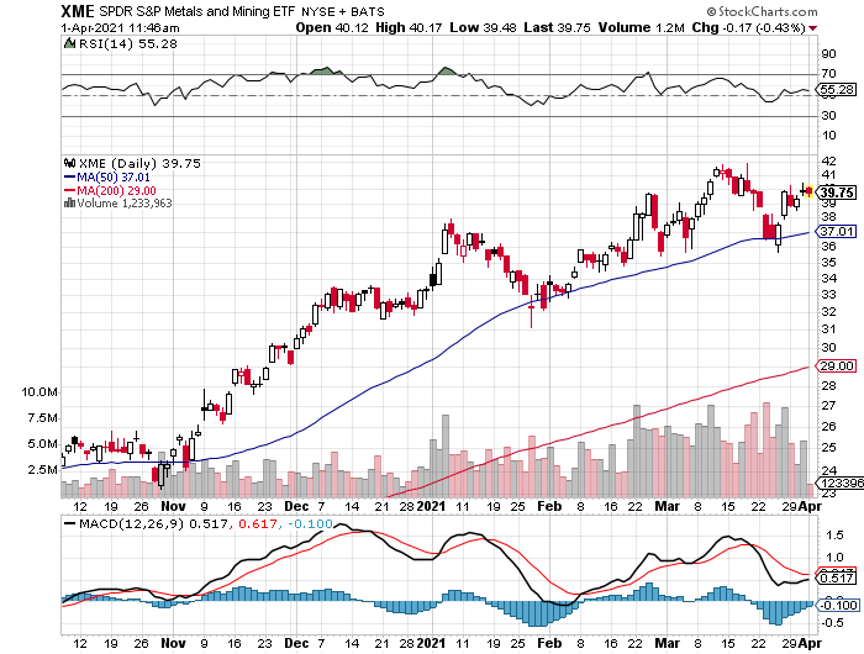
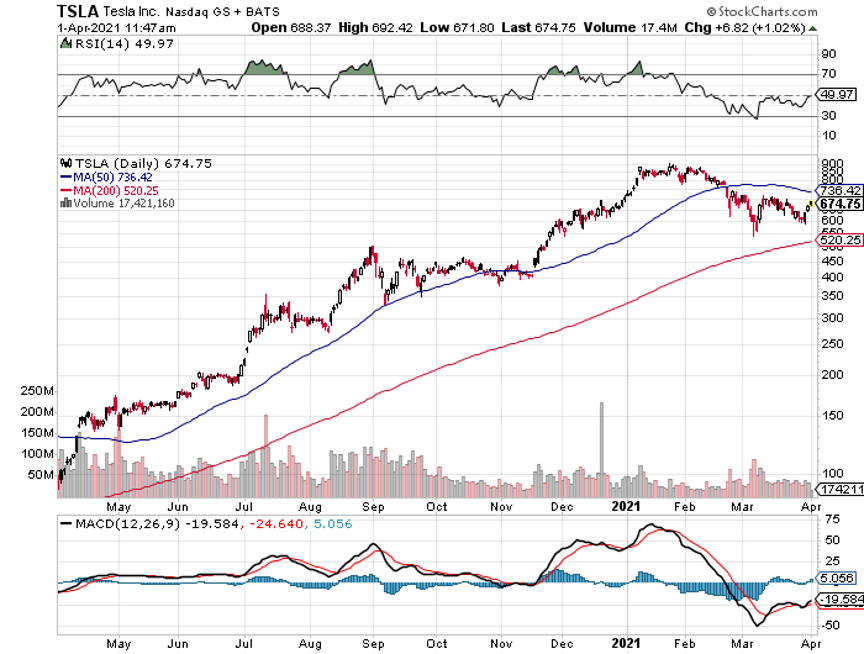
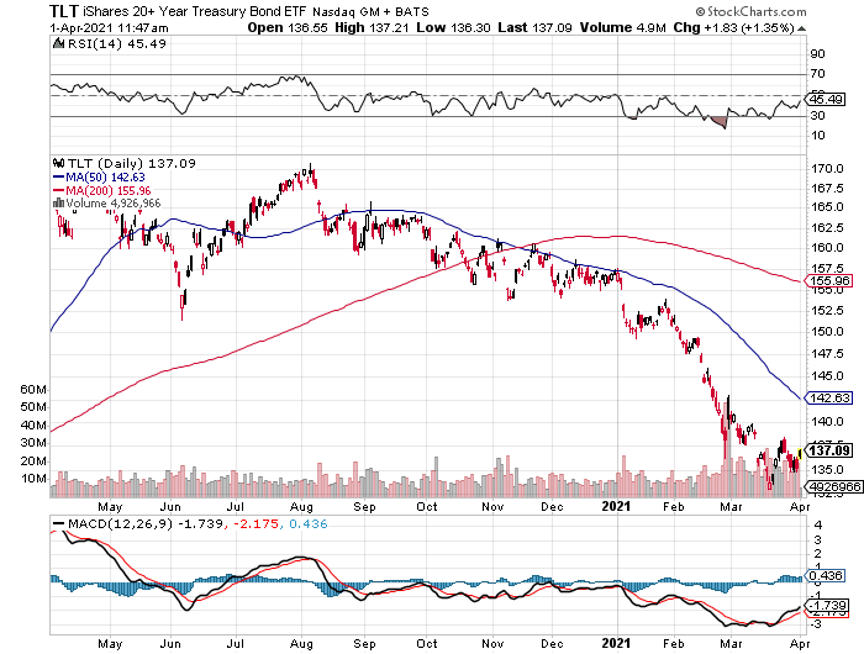

Global Market Comments
March 5, 2021
Fiat Lux
Featured Trade:
(MARCH 3 BIWEEKLY STRATEGY WEBINAR Q&A),
(BRKB), (CRM), (ZM), (AAPL), (AMD), (DIS), (CRSP),
(BRKB), (PLTR), (NVDA), (TLT), (TSLA), (GLD),
(SLV), (VSAT), (EUO), (GME)

Below please find subscribers’ Q&A for the March 3 Mad Hedge Fund Trader Global Strategy Webinar broadcast from frozen Incline Village, NV.
Q: Are SPACs here to stay?
A: Yes, but I think that in the next bear market, 80% of these SPACs (Special Purpose Acquisition Companies) will disappear, will deliver large losses, and will continue charging you enormous fees until then. It’s either that or they won’t invest their money at all and give it back, net of the fees. So, I’m avoiding the SPAC craze unless it's associated with a very specific investment play that I know well. The problem with SPACs is that they all come out expensive—there are no bargain basement SPACs on launch day. Me, being the eternal cheapskate that I am, always want to get a great bargain on everything. The time to buy these is actually in the next bear market, if they still exist, because then investors will be throwing their positions away at 10 or 20% discounts. That’s always what happens with specialized ETF, closed-end funds, and so on. They are roach motel investments; you can check-in, but you can never check out.
Q: What do you think of Elizabeth Warren's asset tax idea?
A: It’s idiotic. It would take years to figure out how much Jeff Bezos is worth. And even then, you probably couldn't come within ten billion dollars of a true number. We already pay asset taxes, our local county real estate taxes, and those are bad enough, delivering valuations that are miles from true market prices. There are many other ways to fix the tax system and get billionaires paying their fair share. There are only three things you really have to do: get rid of carried interest so hedge funds can’t operate tax-free, get rid of real estate loss carry forwards which allow the real estate industry to basically operate tax-free, and get rid of the oil depletion allowance, which has enabled the oil industry to operate tax-free for nearly 90 years. So those would be three easy ones to increase the fairness of the tax system without any immense restructuring of our accounting system.
Q: When will share buybacks start?
A: They’ve already started and have been happening all year. There are two ways the companies do this: they either have an outside accounting firm, buying religiously every day or at the end of every month or something like that, so they can’t be accused of insider trading; or they are in there buying on every dip. Certainly, all the big cash-heavy companies like Berkshire Hathaway (BRKB) or Apple (AAPL) were buying their shares like crazy last March and April because they were trading such enormous discounts. So that is another trillion dollars sitting under the market, waiting to come in on any dip, which is yet another reason that we are not going to see any major sell-offs this year—just the 5%-10% variety that I have been predicting.
Q: Is it time to buy Salesforce (CRM)?
A: Yes, Marc Benioff’s goal is to double sales in two years, and the stock is relatively cheap right now because they’ve had a couple of weak quarters and are still digesting some big acquisitions.
Q: Is CRISPR Therapeutics (CRSP) good buy?
A: Yes, I would be buying right here; it’s a good LEAP candidate because the stock could easily double from here. We’ve only scratched the surface on CRISPR technology being adopted and the potential growth in this company is enormous—I'm surprised they haven’t been taken over already.
Q: Will you start a letter for investing advisors on how to deal with the prolific numbers of Bitcoin?
A: There are already too many Bitcoin newsletters; there are literally hundreds of them and thousands of experts on Bitcoin now because there’s nothing to know and nothing to analyze. It’s all a belief system; there are no earnings, there are no dividends, and there is no interest. So, you purely have to invest in the belief that somebody else is going to take you out at a higher price. I think there is a big overhang of selling in that when they raise the number of Bitcoin, we’ll get another one of those 90% crashes that Bitcoin is prone to. So, go elsewhere for your Bitcoin advice; your choices are essentially unlimited now, and they are much cheaper than me. In fact, people are literally giving away Bitcoin advice for free, which means you’re getting what you’re paying for. I buy Bitcoin when they have a customer support telephone number.
Q: Zoom (ZM) has come down a lot after a big earnings report—do you like it?
A: Long term, yes. Short term, no. You want to avoid all the stay-at-home stocks because no one is staying at home anymore. However, there is a long-term story in Zoom once they find their bottom because even after we come out of the pandemic, we’re all still using Zoom. I have like five or ten Zoom meetings a day, and my kids go to school on Zoom all day long. They’re also bringing out new products like telephone servers. They’re also raising their prices—I happen to be one of Zoom’s largest customers. I’m paying $1,100/month now, and that’s rising at 10% a year.
Q: What would be the best LEAP for Salesforce (CRM)?
A: The rule of thumb is that you want to go 30% out of the money on your first strike. So, find a current stock price; your first strike is up 30%, and then your second strike is up 35%. And all you need to double your money on that is a bounce back to the highs for this year, which is not unrealistic. That’s the lay-up there with Salesforce. That’s the basic formula; Advanced Micro Devices (AMD), Walt Disney (DIS), Berkshire Hathaway (BRKB), Palantir (PLTR), and Nvidia (NVDA) are all good candidates for LEAPS.
Q: How often do you update the long-term stock portfolio?
A: Twice a year, and we just updated in January, which is posted on the website in your membership area. If you can't find it, just email customer support at support@madhedgefundtrader.com and they’ll tell you where to find it. And we only do this twice a year because there just aren't enough changes in the economy in six months to justify a more frequent update.
Q: When do you think real estate will come back?
A: It never left. We’ve had the hottest real estate market in history, with 20% annual gains in many cities in 2020. And that will continue, but not at the 20% rate, probably at a more sustainable 5% or 6% rate. Guess what the best inflation play in the world is? Real estate. If you’re worried about inflation, you want to run out and buy a house or two. The only thing that will really kill that market is a rise in 30-year fixed-rate mortgages to 5%, and that is years off. Or a rise in the ten-year treasury to 5% or 6%—that is several years off also. So, I think we’ve got a couple of good years of gains ahead of us. I at least want the market to stay hot until my kids get out of high school, and then I can sell my house and go live on some exotic tropical island with great broadband.
Q: When you’re doing LEAPS, do you just do the calls only or do you do these as spreads?
A: You can do both. Just do the math and see what works for you on a risk/reward basis. You can do a 30% out of the money call 2 years out and get anywhere from a 1,000% to a 10,000% return—people did get 10,000% returns buying deep out of the money LEAPS in Tesla (TSLA) a year ago (that’s where all the vintage bourbon is coming from). Or you can do it more conservatively and only make 500% in two years on Tesla spread. For example; do something like a Tesla January 2023 $900-$950 call spread. If Tesla shares rise to $950, that position is an easy quadruple. But do the numbers, figure out the cost today, what the expiration value is in two years, and there you go.
Q: Do you think overnight rates could go negative as some people predict?
A: Not for a long time. They will go negative at the next recession because we’re starting off such a low base—or when we get the next pandemic, which could be as early as next year. We could get another one at any time from a completely different virus, and it would generate the same stock market results that we got last time—down 40% in a month. We’re not out of the pandemic business, we’re just having a temporary break waiting for the next one to come along out of China or some other country, or even right here in the USA. So that may be a permanent aspect of investing in the future. It could be the price we pay having a global population that's at 7 billion heading to 9 billion.
Q: Expiration on LEAPS?
A: I always go out two years. The second year is almost free, that’s why. So why not go for the second year? It gives you twice as much time to be right, always useful.
Q: My two-year United States Treasury Bond Fund (TLT) $125 put LEAPS have turned very positive. Is this a good trade?
A: That is a good trade, which you should put on during the next (TLT) rally. If you think we’re going to $105 in 2 years, do something like a $127-$130 two-year put LEAP, and there's a nice four bagger right there.
Q: Your Amazon (AMZN) price target was recently listed at $3,500, below last year's high, but I’ve also seen a $5,000 forecast in two years. Are you sticking with that?
A: Yes, I think when you get a major recovery in the economy, Amazon will be one of the only pandemic plays that keeps on going. It’s just taking a rest here with the rest of big tech. The breakup value of Amazon is easily $5,000 a share or more. Plus, they’re still going gangbusters growing into new industries that they’ve barely touched so far, like pharmaceuticals, healthcare, and so on. So yes, I would definitely be a buyer of LEAPS, and you could do something like the January 2023 $3700-$4000 LEAP two years out and make a killing on that.
Q: Anything you can do in gold (GLD)?
A: Not really. Although gold and silver (SLV) have been a huge disappointment this year, I think this could be the beginning of a capitulation selloff in gold which will bring us a final bottom, but it may take another month or two to get there.
Q: How can I sell short the dollar?
A: You sell short the (UUP), or there are several 1X and 2X short ETFs in the currencies that you can do, like the ProShares Ultra Short Euro ETF (EUO). That is the way to do it.
Q: What is the best timing for buying LEAPS?
A: Buy at market bottoms. A year ago, I was sending out lists of 10 LEAPS at a time saying please buy all of these. You need both a short-term selloff in the stock, and then an upside target much higher than the current price so your LEAP expires at its maximum profit point. And if you’re in the right names, pretty much all the names that we talk about here, you will have 30%, if not 300% or 3,000% gains in them in the next two years.
Q: Do you think Tesla’s Starlink global satellite system will disrupt the cell tower industry?
A: Yes, that is the goal of Starlink—to wipe out all ground communication for WIFI and for cell phones. It may take them several years to do it, but if they do pull it off, then it just becomes a matter of pricing. The last Starlink pricing I looked at cost about $500 to set up, open the account, and get your dish installed. And the only flaw I see in the Starlink system is that the satellite dishes are tracking dishes, which means they lock onto satellites and then follow them as they pass overhead. Then when that signal leaves, it locks onto a new satellite; at any given time they’re locked onto four different satellites. That means moving parts, and you want to be careful of any industry that has moving parts—they wear out. That’s the great thing about software and online businesses; no moving parts, so they don’t wear out. And that’s also why Tesla has been a success; they eliminated the number of moving parts in cars by 80%. I’m waiting for Starlink to get working so I can use it, because I need Internet access 24 hours a day, even if all the local hubs are out because of a power outage. I’m now using something called Viasat (VSAT), which guarantees 100 megabyte/second service for $55 a month. It's not enough for me because I use a gigabyte service landline, but when that’s not available then I can go to satellite as a backup.
Q: Is there too much Fed liquidity in the market already? Why is the $1.9 trillion rescue package still positive for the market?
A: Firstly, there is too much liquidity in the market; that is screamingly obvious. If you look at liquidity over the decades, we are just staggeringly high right now. M2 is growing at 26% against the normal rate of 5%-6%. What the stimulus package does is get money to the people who did not participate in the bull market from last year. Those are low-income people, cities, and municipalities that are broke and can’t pay teachers, firemen, and policemen. It also goes to individual states which were not invested in the stock market. It turns out that states that were invested in the stock market like California have money coming out of their ears right now. And it gets money to low wage workers with kids who are certainly struggling right now. So, it is rather efficiently designed to get the money to people who need it the most. There is still half the country that doesn't own any stocks or even have savings of any kind. One or two people might get it who don’t deserve it but try doing anything in a 330 million population country and have it be 100% efficient.
Q: Is inflation coming?
A: Only incrementally in tiny pieces, so not enough to affect the stock market probably for several years. I still believe technology is advancing so fast that it wipes out any effort to raise prices or increase wages, and that may be what the perennially high 730,000 weekly jobless claims is all about. Those jobs that might have been there a year ago have been replaced by machines, have been outsourced overseas, or the demand for the product no longer exists. So, as long as you have a 10% unemployment rate and a weekly jobless claim at 730, inflation is the last thing you need to worry about.
Q: Is there any way to cash in on Reddit’s Wall Street Bets action?
A: No, and I would bet the majority of people who are trading off of these emojis and Reddit posts are losing money. You only hear about these things after it’s too late to do anything about them. I don't think you’ll get any more $4 to $450 moves like you did with GameStop (GME) because in that one case only, there was a short interest of 160%, which should have been illegal. All the other high short interest stocks have already been hit, with short interests all the way down to 30%, so I think that ship has sailed. It has no real investing merit whatsoever.
Good Luck and Stay Healthy.
John Thomas
CEO & Publisher
The Diary of a Mad Hedge Fund Trader

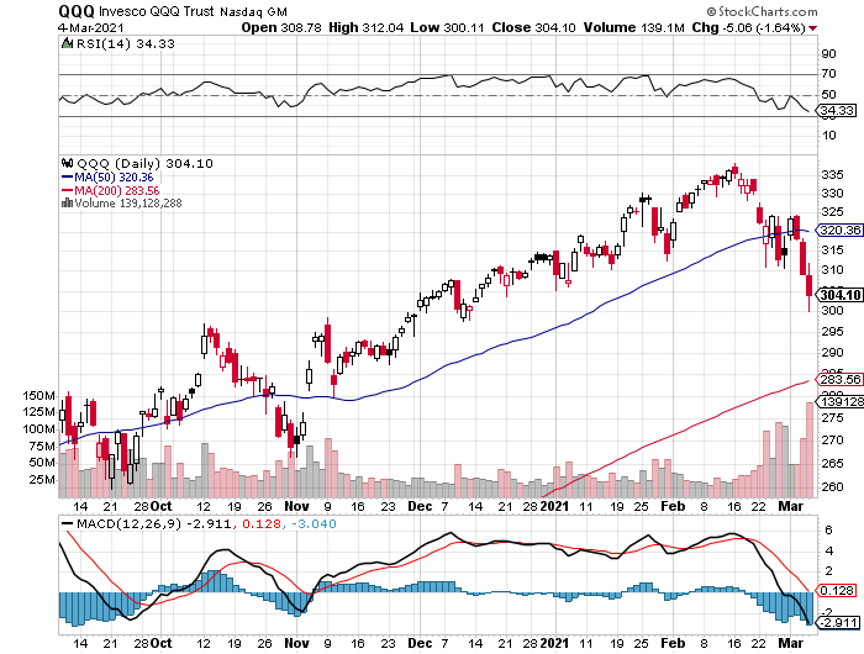
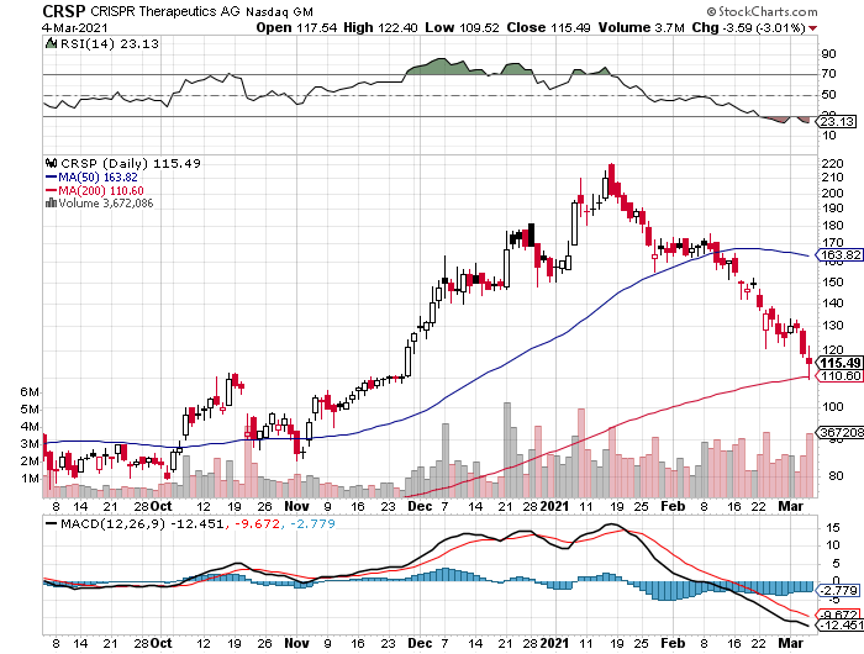

Legal Disclaimer
There is a very high degree of risk involved in trading. Past results are not indicative of future returns. MadHedgeFundTrader.com and all individuals affiliated with this site assume no responsibilities for your trading and investment results. The indicators, strategies, columns, articles and all other features are for educational purposes only and should not be construed as investment advice. Information for futures trading observations are obtained from sources believed to be reliable, but we do not warrant its completeness or accuracy, or warrant any results from the use of the information. Your use of the trading observations is entirely at your own risk and it is your sole responsibility to evaluate the accuracy, completeness and usefulness of the information. You must assess the risk of any trade with your broker and make your own independent decisions regarding any securities mentioned herein. Affiliates of MadHedgeFundTrader.com may have a position or effect transactions in the securities described herein (or options thereon) and/or otherwise employ trading strategies that may be consistent or inconsistent with the provided strategies.
This site uses cookies. By continuing to browse the site, you are agreeing to our use of cookies.
OKLearn moreWe may request cookies to be set on your device. We use cookies to let us know when you visit our websites, how you interact with us, to enrich your user experience, and to customize your relationship with our website.
Click on the different category headings to find out more. You can also change some of your preferences. Note that blocking some types of cookies may impact your experience on our websites and the services we are able to offer.
These cookies are strictly necessary to provide you with services available through our website and to use some of its features.
Because these cookies are strictly necessary to deliver the website, refuseing them will have impact how our site functions. You always can block or delete cookies by changing your browser settings and force blocking all cookies on this website. But this will always prompt you to accept/refuse cookies when revisiting our site.
We fully respect if you want to refuse cookies but to avoid asking you again and again kindly allow us to store a cookie for that. You are free to opt out any time or opt in for other cookies to get a better experience. If you refuse cookies we will remove all set cookies in our domain.
We provide you with a list of stored cookies on your computer in our domain so you can check what we stored. Due to security reasons we are not able to show or modify cookies from other domains. You can check these in your browser security settings.
These cookies collect information that is used either in aggregate form to help us understand how our website is being used or how effective our marketing campaigns are, or to help us customize our website and application for you in order to enhance your experience.
If you do not want that we track your visist to our site you can disable tracking in your browser here:
We also use different external services like Google Webfonts, Google Maps, and external Video providers. Since these providers may collect personal data like your IP address we allow you to block them here. Please be aware that this might heavily reduce the functionality and appearance of our site. Changes will take effect once you reload the page.
Google Webfont Settings:
Google Map Settings:
Vimeo and Youtube video embeds:
